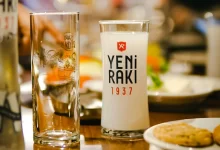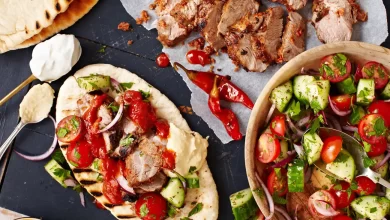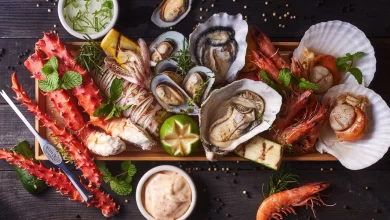
Turkish Baklava is more than just a dessert—it’s a symbol of centuries-old traditions, cultural heritage, and culinary artistry. Originating from the rich kitchens of the Ottoman Empire, baklava has become a treasured delicacy not only in Turkey but also across the Middle East and beyond. Its golden, flaky layers of phyllo dough, filled with finely chopped nuts and soaked in sweet, aromatic syrup, create a texture that is both crisp and melt-in-your-mouth tender.
While variations of baklava exist in different countries, Turkish baklava is distinctive for its use of pistachios, walnuts, and sometimes hazelnuts, depending on the region. It’s carefully crafted, with dozens of paper-thin layers of dough stacked and buttered before baking to perfection. The final touch comes from a pour of sugar syrup or honey, adding the perfect balance of sweetness to the rich, buttery layers.
What Is Turkish Baklava? A Sweet Introduction
Turkish baklava is a classic dessert known for its delicate layers of phyllo pastry, filled with nuts and sweetened with syrup or honey. Considered a masterpiece of Turkish cuisine, it is often hailed for its unique blend of rich flavors and satisfying textures. The dessert typically consists of 30 to 40 layers of thin, buttered phyllo dough, each layer baked to golden perfection. The nut fillings, usually pistachios, walnuts, or hazelnuts, are sandwiched between these layers, creating a beautiful balance of crunch and sweetness.
What sets Turkish baklava apart from other variations is its precise use of ingredients and attention to technique. Authentic Turkish baklava uses a sugar-based syrup flavored with lemon juice, which gives the dessert a light and refreshing sweetness. This differs from Greek or Middle Eastern baklava, which sometimes uses honey-based syrups.
The art of making baklava requires patience and skill, as the layers must be paper-thin and evenly baked. It’s traditionally served in small, bite-sized pieces due to its rich and indulgent nature. Whether enjoyed as a simple dessert or shared during festive occasions, Turkish baklava is a beloved treat that captures the essence of Turkish culinary tradition.

The History of Baklava
The history of baklava is as rich and layered as the dessert itself, with roots that stretch back centuries. While its exact origin is debated, most historians agree that baklava was perfected during the time of the Ottoman Empire, which spanned from the late 13th century to the early 20th century. It’s believed that baklava evolved from ancient Mesopotamian desserts, which combined nuts, honey, and dough. However, the modern form of baklava as we know it today—flaky, layered, and soaked in syrup—was refined and popularized in the Ottoman kitchens.
The royal kitchens of Topkapı Palace in Istanbul were particularly famous for their baklava, with the sultans and their guests enjoying the dessert as a symbol of luxury and prestige. Baklava was such an important part of Ottoman culture that a special ritual called the “Baklava Procession” was held, where trays of the dessert were presented to the sultan’s elite soldiers, known as Janissaries, to celebrate military victories and holidays.
Over the centuries, baklava spread across the Middle East, the Balkans, and the Mediterranean, with each region adding its unique twist to the recipe. However, Turkish baklava remains one of the most beloved and recognized versions, celebrated for its meticulous preparation and cultural significance.
Different Types of Baklava: A Guide to Regional Varieties
While baklava is enjoyed across many cultures, Turkish baklava stands out for its distinct regional variations, each offering a unique twist on the classic recipe. The base of baklava is generally the same—layers of phyllo dough, butter, and nuts—but the type of nuts, syrup, and preparation methods vary depending on the region.
- Gaziantep Baklava: Known as the birthplace of baklava, the city of Gaziantep in southeastern Turkey is famed for its pistachio-filled baklava. Gaziantep baklava uses premium green pistachios, layered between ultra-thin phyllo dough, and topped with sugar syrup. It is a rich, flavorful variation and has even earned a protected geographical indication (PGI) status, marking its quality and authenticity.
- Walnut Baklava: In central and northern regions of Turkey, walnuts are more common than pistachios. Walnut baklava offers a slightly more robust, earthy flavor. The syrup is often a little less sweet to complement the bitterness of the walnuts.
- Sütlü Nuriye: This is a lighter variation that uses milk in the syrup, resulting in a softer and creamier texture. Sütlü Nuriye is often preferred by those looking for a less rich and heavy version of baklava.
- Bülbül Yuvası: Also known as “Nightingale’s Nest,” this version features dough shaped into a nest, with the nuts in the center and drizzled with syrup. It’s a more intricate and artistic variation of the classic dessert.
Each type of Turkish baklava offers a unique taste experience, catering to different palates while preserving the essence of this timeless treat.

How Traditional Turkish Baklava Is Made?
Recipe: Traditional Turkish Baklava
For the Baklava:
- 1 package of phyllo dough (16 oz), thawed
- 1 cup unsalted butter, melted
- 2 cups finely chopped pistachios or walnuts
- 1 teaspoon ground cinnamon (optional)
For the Syrup:
- 1 cup granulated sugar
- 1 cup water
- 1 tablespoon lemon juice
- 1 teaspoon vanilla extract (optional)
Making traditional Turkish baklava is an art that combines high-quality ingredients with precise techniques. The process starts with the key components: phyllo dough, nuts, butter, sugar, and water. The quality of these ingredients significantly impacts the final product, particularly the nuts, which are often chosen for their freshness and flavor.
The first step in creating baklava is preparing the phyllo dough. It is essential to use thin sheets of phyllo, which are usually stacked in layers, with melted butter brushed between each layer to achieve a flaky texture. A typical recipe requires 30 to 40 layers of phyllo, creating the signature crispiness that baklava is known for.
Next, the nut filling is prepared, commonly consisting of finely chopped pistachios or walnuts. Some variations include spices like cinnamon for added flavor. Once the nut mixture is ready, it is spread evenly over the layered phyllo.
After assembling the baklava, it is cut into diamond or square shapes before baking. The dessert is baked until golden brown, releasing a delightful aroma. While the baklava is baking, a simple syrup is made by combining sugar, water, and lemon juice, which is poured over the hot baklava immediately after it comes out of the oven. This step is crucial as it allows the syrup to soak into the layers, enhancing the flavor and moisture. The result is a deliciously rich and sweet treat that embodies the essence of Turkish culinary tradition.

The Role of Baklava in Turkish Culture and Celebrations
Baklava holds a special place in Turkish culture, symbolizing hospitality, celebration, and tradition. Its rich flavors and intricate preparation make it a beloved dessert that is often served during special occasions and festive gatherings. In Turkey, baklava is a staple at weddings, religious holidays like Ramadan and Eid, and family celebrations, representing joy and abundance.
During Ramadan, baklava becomes particularly popular as families gather to break their fasts with a variety of sweets, and baklava often takes center stage. The dessert’s elaborate presentation and delightful taste make it a favorite for sharing, embodying the spirit of generosity that is prevalent during this holy month.
Baklava is also associated with Turkish hospitality, and it is common for hosts to serve this exquisite dessert to guests as a gesture of welcome. In Turkish tradition, serving baklava alongside a cup of strong Turkish coffee signifies a warm and gracious reception.
Moreover, baklava has transcended its culinary roots to become a cultural icon, representing Turkey in international culinary fairs and festivals. This sweet treat not only tantalizes the taste buds but also connects people through shared experiences and traditions, reinforcing its significance in Turkish culture and community life.
Turkish baklava is more than just a dessert; it is a celebration of culture, history, and artistry. Its intricate layers, delightful crunch, and sweet syrup make it a timeless favorite that captures the essence of Turkish hospitality. Whether you’re preparing it for a special occasion or enjoying it as an everyday treat, baklava offers a taste of tradition that transcends borders.
By making this delicious recipe at home, you can experience the joy of creating a beloved culinary masterpiece while connecting with the rich heritage of Turkish cuisine. So gather your ingredients, roll up your sleeves, and indulge in the sweet, flaky delight of homemade baklava. Enjoy the journey and the flavors that make this dessert a cherished symbol of celebration and connection!











